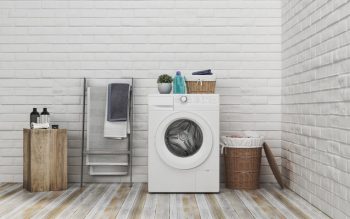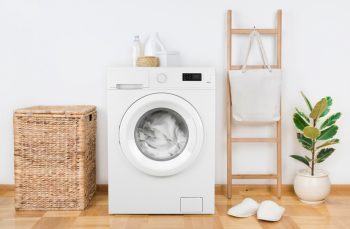
Surviving the heat of summer is nearly impossible without an AC in your workplace and home. It can be frustrating when you try to turn on your unit, but it won’t turn on.
It’s easy to panic as you think about the expensive cost of installing another unit.
You must establish the root cause of why your AC won’t turn on since some issues are easy to fix by yourself, while others require a quick visit by an HVAC technician.
An AC that won’t power on is an indication of a malfunction. While you can troubleshoot some issues by yourself, some problems require the attention of a skilled HVAC professional.
The common reasons why an AC may fail to turn on are:
- An unplugged condenser unit, a clogged air filter, an AC motor failure, a blown fuse, a tripped circuit breaker, or a faulty thermostat.
- Other causes include clogged drain pan/ condensate pipe, dirty evaporator or condenser coils, low refrigerant levels, and AC age.
Read on as we discuss these reasons in detail and offer possible solutions.
This article discusses the common reasons that can make an AC not turn on. We’ll also provide possible solutions on what to do in each case.
Common Reasons Your AC Won’t Turn On
The reasons your AC might fail to turn on include the following:
1. The Condenser Unit Is Unplugged
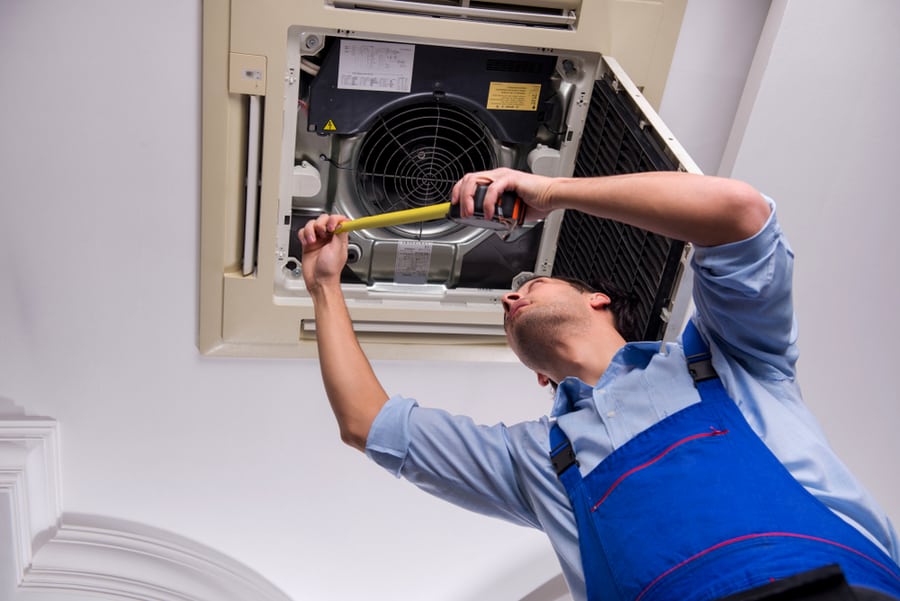
If your condenser/ outdoor unit is not plugged in, power cannot flow through and will not turn on. Ensure you visually inspect the cord that connects to the power source is plugged correctly into the socket, especially if you have a window unit.
Also, you must ensure that you’ve turned on both the indoor and outdoor switches.
2. Clogged Air Filter
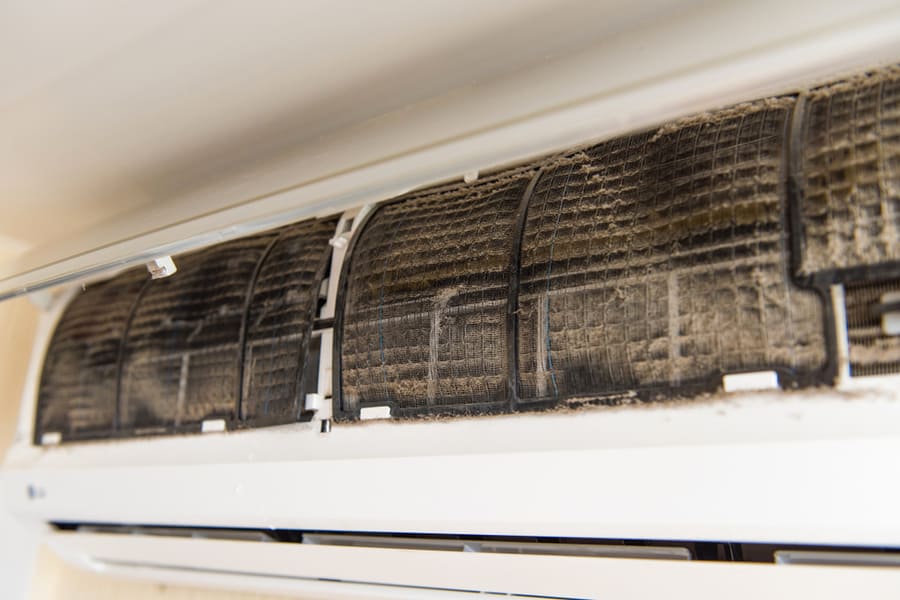
The role of an air filter in an AC is to remove dust from the air flowing through the return ducts into the evaporator coil. Unfortunately, the air filter becomes caked with dust and debris over time. Changing or cleaning your air filter every 30 to 60 days would be best.
Failure to do this restricts airflow, causing the evaporator coil to freeze. As ice builds up on the evaporator coil, the AC may start to short-cycle or fail to turn on entirely.
Solution
If it’s been over two months since you cleaned or changed your air filter, consider attending to it since it could be causing the issue.
However, please turn off the AC and its power supply before removing the air filter. After cleaning/changing the air filter, turn the AC to fan mode to defrost the ice.
Alternatively, use a blow dryer on its lowest setting to melt the ice more quickly. It is vital to ensure that the condenser unit stays off while the ice is defrosting to avoid damaging the air conditioner.
3. AC Motor Failure
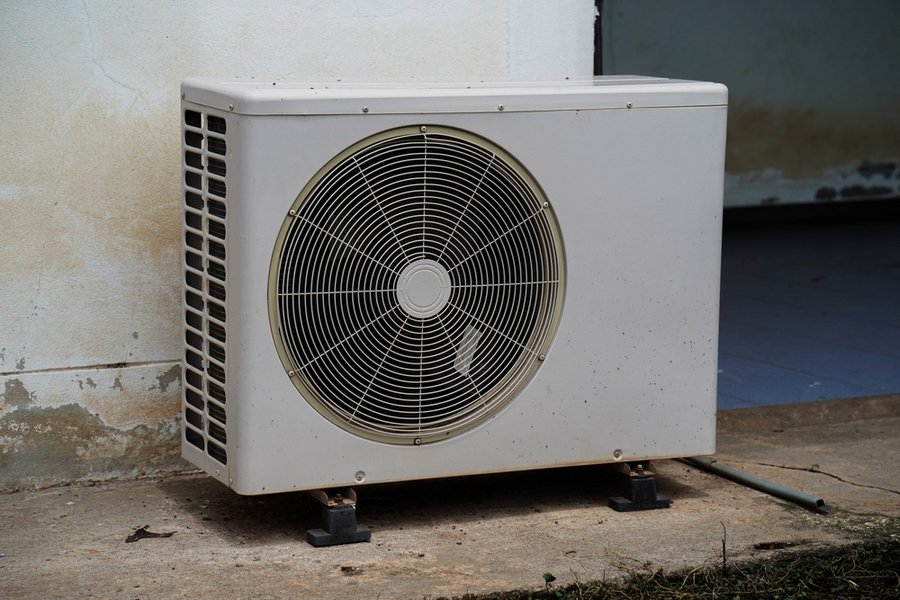
Over time as your AC ages or due to lack of maintenance, the motor and motor blades can wear out due to lack of enough lubrication. In addition, you can tell the motor is faulty if your air conditioner produces a grinding noise as it operates.
Eventually, the AC stops working because an AC can’t function properly with a malfunctioning motor.
Solution
Using a multimeter, you can establish a malfunctioning motor fan by doing a continuity test. If the motor is not the problem, you must consider other causes.
However, if the motor has failed, the next step should be to contact an experienced HVAC expert to thoroughly assess the damage to determine whether it can be replaced or if installing a new air conditioning system would make more economic sense.
4. Your Fuse Is Blown
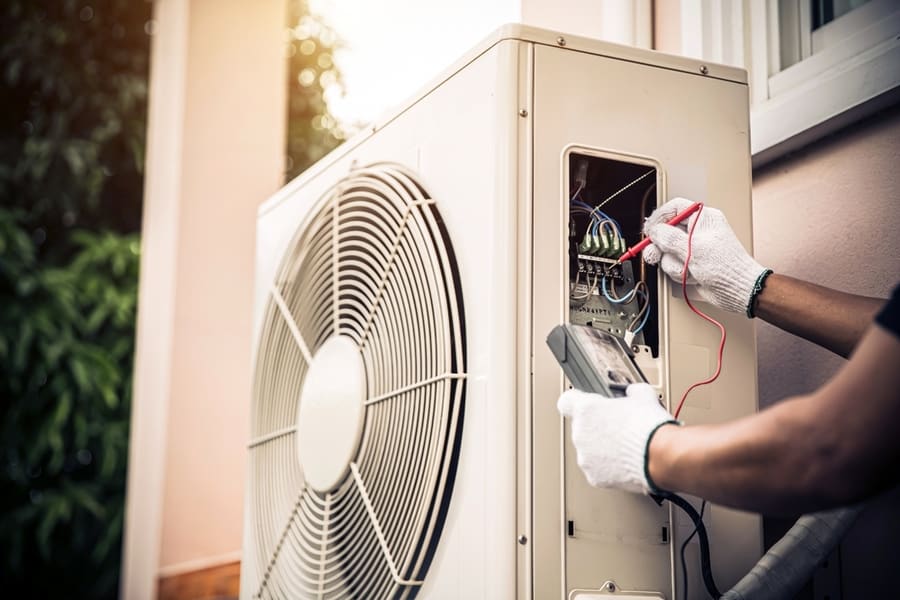
Your AC fuse is usually outdoors in a box adjacent to the condenser unit. The fuse can blow if too much current flows through the system. When the fuse blows, it prevents power flow through the system to avoid damage.
You’ll need to conduct a continuity test using a multimeter to establish if you have blown a fuse. To avoid electrocution, turn off the power supply before testing a fuse for damage.
Solution
If the continuity test proves the fuse is damaged, the solution is to take a picture and visit a hardware store to buy a replacement. Alternatively, you can buy another fuse from online retailers.
Luckily, replacing a fuse is a straightforward process you can handle by yourself, but if you have doubts about how to do it, you should contact a skilled technician.
5. Tripped Circuit Breaker
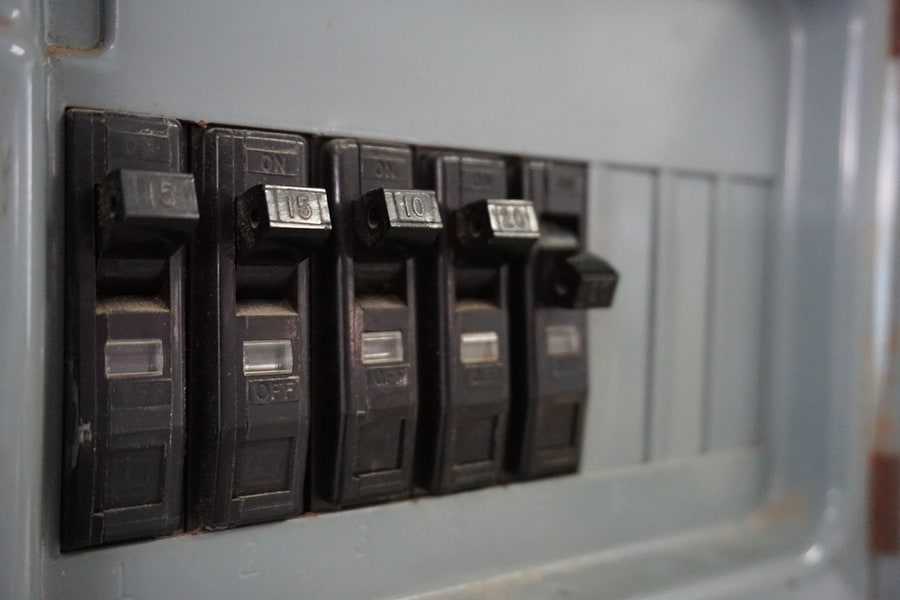
Circuit breakers are installed as a protective measure against electrical shock, fires, and appliance damage.
They resemble switches and turn off or trip when there are power surges in the electricity grid or circuit overloads. The circuit breaker’s sensing mechanism heats up, and the breaker “trips.”
This prevents the passage of current through the circuit. Therefore, if the circuit breaker in your power supply has tripped, your AC cannot turn on.
Solution
To resolve a tripped circuit breaker, reset it to the ON position. This will restore the current flow to the system and turn the AC on.
Start by locating the circuit breaker panel, open it, and you’ll see the switches which control power to different rooms or appliances.
Find the switch that controls power flow to the AC, change it from neutral to off-set, wait a few minutes, and then turn it on. Doing this should restore the current flow and allow you to use the AC.
If the circuit breaker keeps tripping, you should avoid turning it on because it indicates high voltage, which can result in a fire. It is essential that you immediately contact a reliable electrician to fix it.
6. Faulty Thermostat
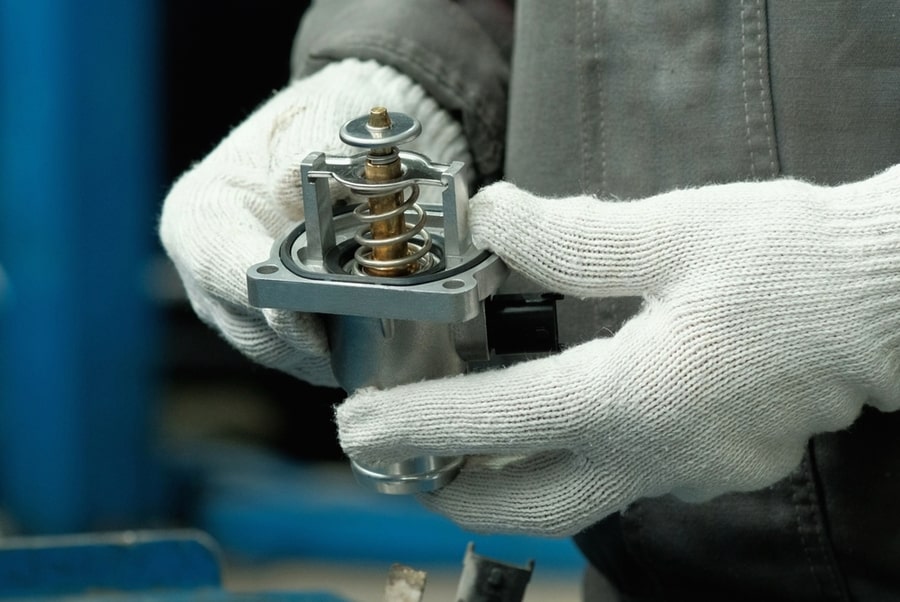
A thermostat is one of the essential parts of an AC. It is the control panel of your air conditioning system and is responsible for communicating the temperature requirements to the rest of the system.
A thermostat may fail to operate correctly if it’s outdated, not well-calibrated if you’ve placed it in a poor location, if it has accumulated dust and dirt, or if the batteries are dead.
Solution
The first step should be to change the thermostat’s batteries and try turning the thermostat on. Next, you must ensure the thermostat is not located opposite a window that allows direct sunlight or near a heat-emitting appliance.
Also, scheduling annual maintenance by a skilled HVAC technician ensures that the thermostat is accurately calibrated and doesn’t give false readings.
Also, consider turning the thermostat off and opening the cover to check whether it has gathered dust and debris. Use a soft brush to clean dust but bring in a technician in case of corroded wires in the thermostat.
An HVAC specialist can repair or replace the thermostat with a new one where necessary.
7. Clogged Drain Pan/ Condensate Pipe
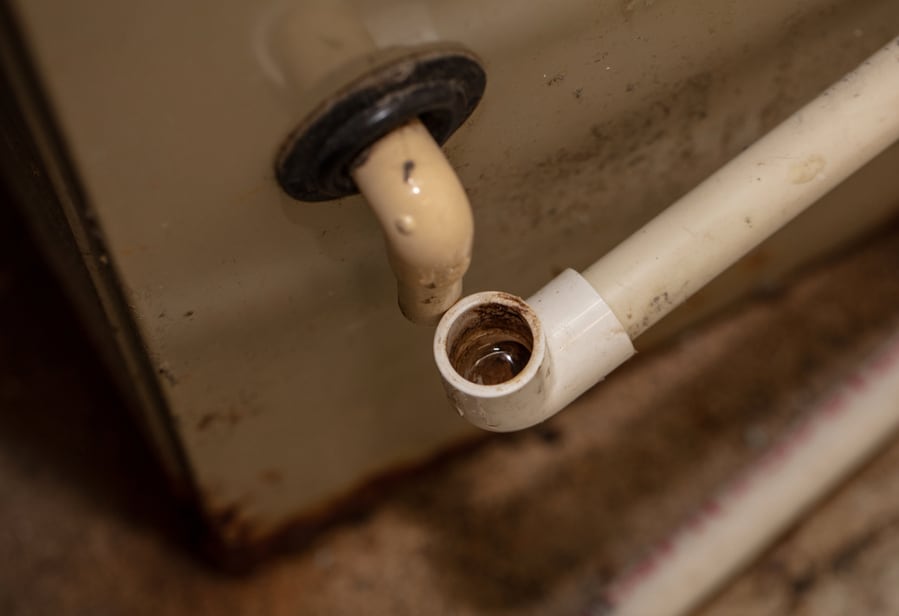
Every AC has a drain pan that collects the condensation water removed from the indoor air. The water then flows out through a condensate drain pipe.
If the drain pipe or pan is clogged due to lack of maintenance, the condensed water may backflow and damage the air conditioning system.
As a safety mechanism, the AC has a float switch that gets triggered if the water volume rises above a specific point. The float switch shuts off the AC to prevent water damage hence why your AC may fail to turn on.
Solution
It is best to keep your condensate pipe and drain pan clean. One of the best ways to do this is to pour a cup of boiling water or vinegar down the condensate pipe at least once a month or use a wet/dry vacuum to suction the clog out.
Also, consider passing a stiff wire through the drain channels occasionally to remove any gunk in the drain pipe.
However, the power supply must be off when cleaning the condensate pipe and pan.
8. Dirty Evaporator or Condenser Coils

The evaporator or condenser coils can gather dust over time. The dirt creates a layer of insulation over the coil, preventing the refrigerant from cooling the air efficiently and emitting heat to the outdoors.
It can also cause the compressor to overheat and shut the system off before the necessary cooling time elapses, also known as short cycling.
However, if the dirt accumulation on the coils is too much, the compressor will overheat and turn off the system entirely.
Solution
You must schedule an annual air conditioner servicing to ensure your evaporator and condenser coils are not caked with dirt.
During the servicing, the HVAC technician cleans the coils thoroughly and assesses them for damage to ensure they remain in excellent condition.
9. Low Refrigerant Levels

A refrigerant is a fluid in a closed loop between the evaporator and condenser coil. It plays a vital role in cooling air and expelling the heat outdoors.
For the AC to function properly, it must have a required amount of refrigerant.
If the refrigerant is less than the required amount, it can cause the compressor to overheat, causing the system to shut down to prevent damage.
Low refrigerant levels can result from leakage in the system or if the HVAC technician who installed the air conditioner did not load it with the correct amount of refrigerant.
Solution
When you turn it on, you can identify a refrigerant leak if your AC produces a hissing sound and a fruity smell. If there is a refrigerant leak, the only solution is to hire a licensed HVAC expert to fix the leak and load the system with the correct refrigerant amount.
Unfortunately, some refrigerants poison humans and the environment, so only licensed practitioners should handle them.
10. Old AC

Ideally, most air conditioners last between 15 to 20 years with proper maintenance. However, after its useful life, it may start being inefficient, eventually shut down, and not turn on, regardless of any repair attempts.
Solution
The best thing to do is to upgrade to a new air conditioner. When upgrading, you should choose an energy-efficient model that abides by the current efficiency standards for air conditioners.
Conclusion
Many reasons can make your AC not turn on. However, some issues are quick to fix, while some can be avoided by ensuring proper unit maintenance.
As a rule of thumb, a skilled HVAC professional must schedule an annual AC servicing if you want to keep your AC in top shape.
Proper care and maintenance can help prolong your AC lifespan, avoid expensive repairs, and avoid the inconvenience of having an AC that won’t work when you need it most.
Frequently Asked Questions
What’s the First Thing I Should Do if My AC Won’t Turn On?
If you switch your AC on, but it doesn’t come to life, you should first confirm that your thermostat is on, ensure that it has active batteries, and replace them if necessary.
If your unit still doesn’t power on, confirm that you’ve plugged in all the essential electrical cords, the necessary switches are on, the circuit breaker has not tripped, and the fuse has not blown.
If that doesn’t work, you must thoroughly inspect your AC or contact a skilled HVAC technician to check and fix it.
How Can I Know if My AC Fuse Has Blown?
An AC fuse can blow if there is a power surge such that too much current flowing through the system. This prevents the flow of power through the system to avoid damage.
You can conduct a continuity test using a multimeter to establish if you have blown a fuse.
However, to avoid electrocution, turn off the power supply before testing a fuse for damage.








